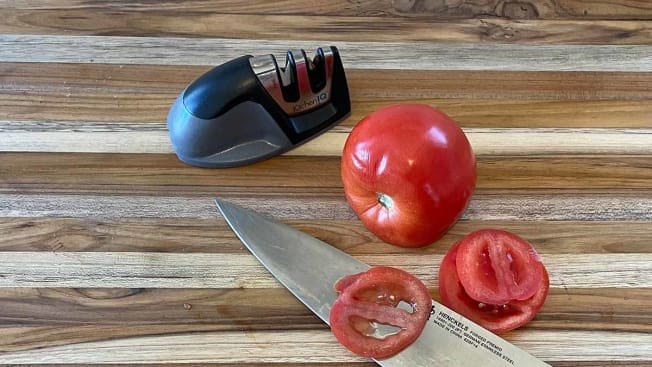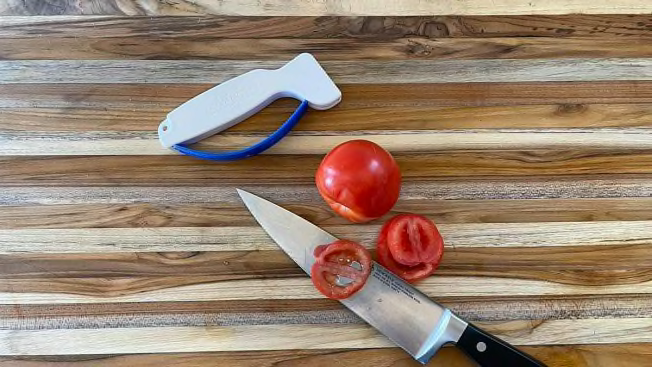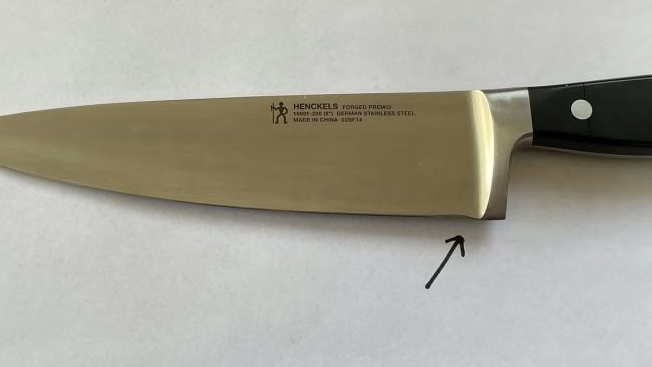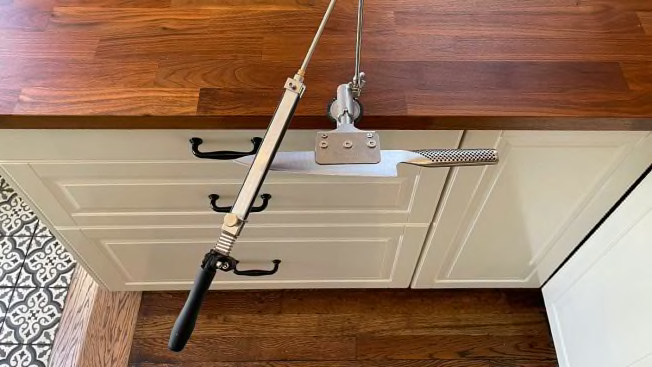Best Knife Sharpeners for Chef’s Knives
I tried electric and manual models from Chef’s Choice, Presto, Wasabi Knives, and other brands to determine which put the best edge on a chef’s knife

By Paul Hope
As long as I can remember, I’ve been obsessed with the idea of a sharp knife. My dad, a former butcher, taught me to sharpen knives, starting around age 6. We used his sharpening stone on weekend trips to my grandmother’s house. In her upstate New York kitchen, I learned first on a small Swiss Army knife before I was allowed to practice on her larger boning and chef’s knives.
When I wasn’t upstate, I’d spend my Saturday mornings channel surfing, bypassing cartoons in search of infomercials for the Ginsu knife. In my early teens, the Ginsu was replaced in my heart by the Miracle Blade, which in turn gave way to my all-time favorite—the Ronco Six Star Cutlery knife set. I was transfixed. These knives could saw through a steel-toed boot or a tin can, only to cut paper-thin slices of tomato in the next shot.
I’ve used hundreds of knives—in culinary school, working in professional kitchens, and now as the resident chef at home—and I can tell you that the real magic isn’t always in the knife so much as in the sharpening. That’s not to say any knife is fine—we found significant differences and clear favorites in CR’s evaluation of chef’s knives.
But I’d rather cut with a crummy knife that has been recently sharpened than a stellar knife with a dull blade.
To find the best knife sharpeners out there, I wanted to try models that were distinctly different in design. I knew that would include traditional offerings you see at retail, like electric countertop and manual sharpeners from big brands such as Chef’s Choice and Presto. I also wanted to include at least one traditional whetstone, since it’s how I first learned, and frankly, it was the only way to sharpen knives for thousands of years. And in a nod to my early obsession with infomercials, I had to include the Wasabi Knives’ Iki Ruixin Pro—a fascinating tool that resembles a medieval torture device and has been dominating the ad space in my Instagram feed for about a year now. I also included the Work Sharp Precision Adjust Knife sharpener, which operates on a similar principle to the Wasabi but costs about $60 less. In each case, I looked for top-selling, highly rated items, and scoured all corners of the internet to find the sharpeners that home cooks seem to love.
Here’s a quick look at the sharpeners I evaluated:
First: The Knives
To assess knife sharpeners, I took two standout knives from our recent test of the best chef’s knives: The J.A. Henckels Forged Premio 8-Inch Chef’s Knife, which is a German-style knife, and the Global G-2 8-inch Chef’s Knife, a Japanese blade. German knives tend to be made from thicker steel and are sharpened to a broader edge. Historically, that edge was about 20 degrees, but nowadays, some German knives are coming factory-sharpened to a finer, 15-degree angle, as is the case with our Henckels knife. Japanese knives tend to be lighter and sharpened to a finer angle. The Global G-2 is sharpened to an angle between 10 and 15 degrees at the factory.
Here’s why: “Japan has a culture of making different knives, dedicated to specific tasks like cutting up a whole fish or leafy greens,” says Branden Lewis, chef and associate professor at the college of food innovation and technology at Johnson & Wales University in Providence, R.I. Many of these knives are sharpened to finer angles than European cutlery.
Following the growing popularity of Japanese knives, some German knife makers now sell cutlery that comes factory-sharpened to finer angles, in an effort to get an edge—so to speak—on some of the competition from Japan. If you’re into your knives—and you own a diverse portfolio of German- and Japanese-style cutlery—you should opt for a sharpening method that will allow you to sharpen each knife to the correct angle, like a sharpening stone or a sharpener with multiple angle settings and stages. But if you’ve had the same knives kicking around in your kitchen drawer for the past 20 years, you’ll be well-served by pretty much any sharpener.
And at the end of the day, any decent sharpener is going to put an edge on any dull knife. Think of it like this: A knife with a flat edge would 90 degrees, so a difference of 10, 15, or 20 degrees on the edge isn’t something you’re likely to feel while you cut.
How I Evaluated Knife Sharpeners
To start with dull blades, I dragged each knife horizontally across a honing rod 25 times, cringing every moment, until the blade was so dull you’d barely be able to cut cooked pasta with it. One at a time, I sharpened each knife with each sharpener, then tested the edge by plowing through onions and cutting translucent slices of Roma tomatoes, to evaluate how fine the edge felt. Of course I couldn’t measure the exact angle each sharpener produced; it was abundantly clear from chopping produce which knives had been sharpened to a razor edge. I also used each newly sharpened knife to cut thin curls of computer paper, because it has become the telltale test for a sharp knife, and frankly, it’s really fun to do. Admittedly, I went a little overboard—there were so many little nests of shredded paper in my kitchen that my partner said (and she wasn’t wrong) it looked like the room was overrun with mice. Once I was done with one sharpener, I dulled the knives again before moving on. Here’s what I found.
The Results
Every sharpener I tried did at least a decent job of returning an edge to both knives. But some sharpeners clearly produced a finer edge than others, and a handful were tedious to use. At times, some even felt dangerous.
Editor’s Choice: Chef’s Choice Model 15XV 3-Stage Professional Electric Knife Sharpener

Photo: Paul Hope/Consumer Reports
Price: From $148
Where to buy: Amazon, Sur La Table, Walmart
The Chef’s Choice Model 15XV is second to none when it comes to easy, complete sharpening. It removes most of the guesswork and helps you maintain a perfect angle, and it can sharpen pretty much any knife you’ll ever own—even serrated bread knives or sushi and sashimi knives, which are sharpened on only one side.
The tool is designed to sharpen every straight-edged knife to a precise 15-degree angle, which is something of a sweet spot for most new knives. It features three settings: sharpening, honing, and a polishing stage. There’s no setup, no cleanup, and no stress.
Read our full review of the Chef’s Choice Model 15XV.
Best Manual Knife Sharpener: Chef’s Choice Model 4643 AngleSelect Professional Manual Knife Sharpener

Photo: Paul Hope/Consumer Reports
Price: From $50
Where to buy: Amazon, Bed Bath & Beyond, Chef’s Choice
The Chef’s Choice 4643 looks like the analog version of the brand’s electric sharpener, but it works a bit differently. Unlike the electric model XV, which sharpens every knife to a 15-degree angle, this sharpener has two basic sharpening settings, one for sharpening knives to 15 degrees, and another for sharpening knives to 20. As mentioned above, many new German and Japanese knives (including those we used) come factory-sharpened to finer angles than in the past, so check with the manufacturer to see what angle it recommends.
A third stage polishes the edge on any knife, regardless of which sharpening angle you choose.
Like the brand’s electric sharpener, the 4643 feels well-designed, with grooves that hold your knife at the perfect angle as you slowly drag it through the stage. Both knives I sharpened emerged exceptionally sharp—even when I sharpened the Henckels on the broader, 20-degree setting—making this a perfect pick for anyone who’s apprehensive about using an electric sharpener or just looking to save some money and real estate on your countertop and/or in the cabinet.
Budget Manual Knife Sharpener: KitchenIQ Deluxe Diamond Edge Grip 2-Stage Knife Sharpener

Photo: Paul Hope/Consumer Reports
Price: From $11
Where to buy: Amazon, Walmart
It’s hard to believe that this mouse-sized sharpener would be able to put an edge on a knife, but it does.
The KitchenIQ is a simple little sharpener with two stages. The coarse stage is for damaged or seriously dull knives, while the fine slot is for a knife that has just lost its edge.
The angles are set for European-style knives—KitchenIQ doesn’t specify the exact angle—but I still found that both my knives emerged with a sharp edge that allowed it to effortlessly slice through onions and tomatoes. The sharpener can be held flat on a countertop, but it also has a notch on the underside, so you can position and hold it on the edge of your counters, too. It’s perfect for quick sharpenings and easily fits in a drawer. One caveat: Because it’s so small, your fingers end up quite close to your knife as you’re sharpening. The manual Chef’s Choice, above, is a better bet if you’re worried about a possible mishap.
Best Sharpening Stone: Sharp Pebble Premium Whetstone Knife Sharpening Stone

Photo: Paul Hope/Consumer Reports
Price: From $40
Where to buy: Amazon, Sharp Pebble, Walmart
The Pebble Premium is a double-sided sharpening stone with a coarse and fine side on the same stone. This stone is 1,000 grit on the coarser side, and 6,000 on the finer side—perfect for sharpening and polishing a dull knife, but you’ll want something coarser (indicated by a number below 1,000) if you need to reshape the edge of a seriously dull knife. Sharp Pebble sells a 400-grit stone for about $28.
If the sharpening process is something you enjoy, this might be the way to go. You can sharpen any knife to the exact angle you want—a tool called a bevel gauge (sold at hardware stores) can help you find the angle—and you just get the most control of any option here. The stone needs a 10- to 12-minute soak before you work, so it’s best to sharpen all your knives at once. It put an edge on both of our knives that none of the electric or manual sharpeners could match, and I found the process relaxing, making it my top choice for cooks who are serious about sharp blades.
Read our full review of the Sharp Pebble Premium Whetstone Knife Sharpening Stone.
AccuSharp Knife & Tool Sharpener

Photo: Paul Hope/Consumer Reports
Price: From $10
Where to buy: Amazon, Bed Bath & Beyond, Walmart
The AccuSharp is pretty different from most of the options here, in large part because it’s designed to tackle tool blades in addition to knives.
For sharpening knives, it has one glaring shortcoming: You use the sharpener by holding a knife steady, blade up, on your countertop. Then you drag the sword-handle-shaped sharpener across the edge of your knife while applying downward pressure. It’s easy to see how a single misstep could end poorly. The sharpener certainly works, but it feels more aggressive than the fine settings you’ll see on other manual sharpeners, leaving you with the distinct feeling that you’re shaving off more metal than you need to in order to restore an edge.
While it feels a little aggressive and at times dangerous for chef’s knives, it claims it can also sharpen lawn mower blades, axes, and machetes (?!), making it a potentially valuable tool in your garage, if not your kitchen.
Presto EverSharp Electric Knife Sharpener

Photo: Paul Hope/Consumer Reports
Price: From $40
Where to buy: Amazon, Target, Walmart
The Presto EverSharp produces seriously sharp knives, even if it lacks the refinement of the Chef’s Choice electric sharpener. It features two sharpening stages instead of three and can’t be used on serrated knives. My main issue with the Presto is that it somehow felt both underpowered and overly aggressive in terms of how much metal it removes. It bogged down several times, stopping the motor entirely until I removed the knife from the guides and started again.
The first stage of the sharpener also seemed to remove so much metal that even a split-second pause when I was pulling the knives through resulted in a small dip forming at the back of the blades, where the sharpener clearly took off more metal than I would have liked (shown below). Aside from the inconvenience of having to even out the edge, a sharpener that removes too much metal ultimately shortens the life of your knife.
That said, it’s about a third of the price of the Chef’s Choice electric sharpener, and still delivered a sharp edge. After the initial learning curve, I got better at using it, too. If you’re not obsessed with cutlery or have a cheaper set of knives, it would certainly work, but for the money, you might be better off with one of the manual sharpeners we tested.

A split-second pause when sharpening resulted in a small dip forming at the back of blade.
Photo: Paul Hope/Consumer Reports
Wasabi Knives Iki Ruixin Pro Sharpener + 4 Whetstones Set

Photo: Paul Hope/Consumer Reports
Price: From $119
Where to buy: Wasabi
The Wasabi Knives’ Iki Ruixin Pro arrives as little more than a bag of metal rods and clamps, and at times, I thought I should have left it that way. After a fairly tricky assembly, you’re left with a sharpener that resembles an erector set, clamped to the edge of your counter. The Ruixin Pro is basically a sharpening stone in reverse—you mount your knife into the sharpener, then use the tool to drag a series of ever-finer sharpening stones across the edge of the blade.
Between assembly, soaking the sharpening stones, and mounting the knife in the tool—which requires loosening and tightening five different fasteners—it took me 15 to 20 minutes to even start sharpening. You also need to use a level app on a phone or a digital level to adjust the Ruixin Pro to the correct angle for each knife you sharpen. To say the process is cumbersome is generous. That said, I can’t argue that the knives emerged exceptionally sharp, akin to the results we got from our sharpening stone, meaning I can see the appeal of the Ruixin Pro for someone who loves to tinker. My advice? If you buy one, set it up in a workshop or anywhere you can keep it assembled all the time to avoid the aggravation of assembly each time your knife loses its edge.
Read our full review of the Wasabi Iki Ruixin Pro Sharpener + 4 Whetstones Set.
Work Sharp Precision Adjust Knife Sharpener

Photo: Paul Hope/Consumer Reports
Price: From $50
Where to buy: Amazon, Work Sharp Tools
The Work Sharp operates on the same basic premise as the Wasabi, above, in that you clamp your knife to the tool, then drag a series of stones across the edge of the blade. But unlike the Wasabi, this tool feels polished and ready for primetime. There’s only about 30 seconds of assembly, and all the parts are attached to the tool. You clamp your knife to the sharpener with a simple dial (instead of a network of five screws), and even the sharpening stones are permanently attached—there are three in total, and you can rotate between them to adjust the coarseness. These stones (unlike those used on the Wasabi) don’t need to be soaked in water before each use.
The one downside I found in the Work Sharp is that it felt a bit small for an 8-inch chef’s knife, so I had to do my best to steady the sharpener so it wouldn’t tip over—not dangerous per se, but annoying. To adjust your sharpening angle, you simply rotate a dial that automatically raises and lowers the stone—there are numbers printed on the tool so you know exactly what angle you’re getting without the need to use a separate level.
All in all it’s an effective tool, but I still can’t help but think the Work Sharp, much like the Wasabi, is a solution in search of a problem. Both tools certainly work to sharpen knives, but neither seems necessary—in the time it takes to familiarize yourself with the tool, you could master sharpening knives on a stone.
This product evaluation is part of Consumer Reports’ Outside the Labs review program, which is separate from our laboratory testing and ratings. Our Outside the Labs reviews are performed at home and in other native settings by individuals, including our journalists, with deep subject matter experience or knowledge and are designed to offer another important perspective for consumers as they shop. While the products or services mentioned in this article might not currently be in CR’s ratings, they might eventually be tested in our laboratories and rated according to an objective, scientific protocol.
Like all CR evaluations of products and services, our Outside the Labs reviews are independent and free from advertising. If you’d like to learn more about the criteria for our lab testing, please go to the Research and Testing page on our website.
Consumer Reports is an independent, nonprofit organization that works side by side with consumers to create a fairer, safer, and healthier world. CR does not endorse products or services, and does not accept advertising. Copyright © 2022, Consumer Reports, Inc.
